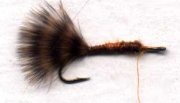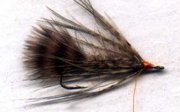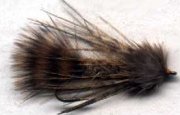This article, Tying the Sparrow, is part 1 of a two-part series on the Gartside Sparrow nymph. Part 2 of this series is Fishing the Sparrow.

Tying the Sparrow
I tied the first Sparrow over twenty-five years ago while camping at Baker's Hole on the Madison just outside West Yellowstone, Montana. Being a lazy fisherman, I hated changing flies any more than was absolutely necessary and wanted a fly that I could fish as a nymph or as a streamer or even as a passable hopper imitation (greased to float, sunken as a drowned grasshopper). So I was looking to come up with an impressionistic fly that would combine some of the common features of both insect and baitfish, a fly that could look (depending on how it was fished and its overall size) like lots of things in general and nothing in particular. I would let the fish make up its own mind as to what it was.
After the usual trials and errors, I eventually hit upon the combination of materials and structure that has come to be known as the Sparrow, a name given to the fly by my friend, Pete Laszlo of New Hampshire, who when he saw a pile of newly-tied flies, said that they looked like of flock of sparrows. At various times and in sundry places, the fly has also been called the "Philo Fly," the "Gartside Pheasant Nymph," and the "Swallow," a name given to it by Don Kast and which is still used along the Gallatin. "Sparrow" or "Swallow" — whatever you choose to call it, it's a fly well worth tying and trying.
Tying Steps
|
Hook: |
Mustad 9671, Daiichi 1710, Tiemco 2312 or similar Sizes: #4-14 |
|
Thread: |
Danville's 6/0, tan, orange, olive, gray, or cream |
|
Tail: |
Pheasant or grizzly rump marabou feather (s); tail length roughly 1/4 length of shank |
|
Body: |
Rabbit and squirrel blended with antron. Two parts squirrel to one of rabbit. Body should be rough, ragged and "buggy." Original Sparrow was tied in Olive but many other colors are useful. |
|
Hackle: |
Pheasant rump hackle tied in as a collar, to extend at least to the tip of the tail. |
|
Head: |
Pheasant aftershaft feather(s) wound around shank just in front of collar. |
 Pluck a short pheasant or grizzly rump feather from skin. Draw the stem of this feather between your thumb and forefinger to gather all the fibers into a squarish, brush-like clump and tie in at a point just forward of the bend of the hook.
Pluck a short pheasant or grizzly rump feather from skin. Draw the stem of this feather between your thumb and forefinger to gather all the fibers into a squarish, brush-like clump and tie in at a point just forward of the bend of the hook.
Do not trim off butt at tie-in point but rather use them as an underbody by winding your thread over them as they lie on top of the shank. Trim butt approximately 1/4 of a shank length back from the eye.
 Return thread to the base of the tail. Apply dubbing to thread and wind forward, tapering the body as you do so, with the thorax area being thicker than the rear. Dub to point where under body ends.
Return thread to the base of the tail. Apply dubbing to thread and wind forward, tapering the body as you do so, with the thorax area being thicker than the rear. Dub to point where under body ends.
 Tie in pheasant rump hackle of appropriate size (concave side down) just in front of body and take one turn of hackle, folding the hackle to the rear as you wind it around the hook, making sure you get an equal distribution of barbs. Trim off excess.
Tie in pheasant rump hackle of appropriate size (concave side down) just in front of body and take one turn of hackle, folding the hackle to the rear as you wind it around the hook, making sure you get an equal distribution of barbs. Trim off excess.
 Tie in aftershaft feather (by the butt) just in front of the collar.
Tie in aftershaft feather (by the butt) just in front of the collar.
 Wind aftershaft feather forward, taking one turn in front of another until you reach the eye of the hook. Tie down feather and trim excess. At this point you might want to dampen your fingers slightly and stroke any stray fibers away from the eye area before tying off and forming small thread head.
Wind aftershaft feather forward, taking one turn in front of another until you reach the eye of the hook. Tie down feather and trim excess. At this point you might want to dampen your fingers slightly and stroke any stray fibers away from the eye area before tying off and forming small thread head.
Tying Notes
The Sparrow is a very simple fly to tie, but to guide the tyer, it may be helpful to consider the construction of the fly, why I've chosen a particular material, and to explain my thinking about its relationship to the overall "effect" of the fly.
The Tail
For the tail I use the short and square-tipped, reddish-brown marabou-like and lively feather from a cock pheasant rump or (lately) the same feather from a grizzly cock or hen which I sometimes dye up in various colors to match the overall color of the body. The tail should be short (about one-third the length of the shank) and square, to suggest either the tail of a small baitfish or perhaps part of a nymphal shuck.
The Body
The body of the Sparrow is made up of a mixture of dyed rabbit and gray or red squirrel— two parts squirrel to one part rabbit.
Rabbit fur is long and soft and nicely translucent underwater; squirrel body fur is quite the opposite: short and bristly and rather opaque. The different textures of the furs work well together. The rabbit fur is the base and the binding and the dominant color of the body. The squirrel fur breaks up the solid color of the rabbit and adds to it a number of other colors; when wet, these shorter strands also tend to trap air bubbles within their scragginess, to diffuse the light pattern in a more impressionistic, lifelike, and alluring manner.
The Collar
For the collar hackle I use a long and soft, multi-hued rump feather from a cock pheasant, a feather that blends well with a wide variety of body color combinations and suggests very well either insect legs or perhaps the "ghost outline" of a baitfish. It's important to choose a feather whose tips, when wound, extend at least to the tip of the tail; never shorter and sometimes longer — and always sparse (one turn of hackle).
The Head
The head of the Sparrow is formed by winding one or two pheasant aftershaft feathers (found beneath and attached to almost any one of the main body feathers) just in front of the collar to suggest the head of a small baitfish or perhaps a nymphal wing case. (Before the Sparrow became "the" Sparrow, it was tied with an exaggerated head of very wide aftershaft feathers, to suggest the outline of the sculpin, a favorite food fish found in the Madison and many other waters).
If you've not used this feather before, you'll immediately discover that it's tip is very fragile. My suggestion is to tie the feather in by the butt and then to break off the tip with your fingers before attempting to wind the feather around the hook. Another suggestion. Instead of hackle pliers, use an E-Z mini-hook; this wonderful little tool — originally used in the electronics industry as a test clip — is far superior to any pair of hackle pliers you'll ever use and is especially efficient when working in small spaces or with fragile materials such as the aftershaft feather.
Color
I tie the Sparrow in a wide variety of colors but the one I use most frequently for trout (and the original color) is a mix of olive-dyed rabbit and natural squirrel body (either red or gray squirrel). Other useful colors for trout are: tan, hare's ear, red squirrel, orange and pink (rainbows love these colors). A black version of the Sparrow, which I call the Evening Star — with a body of peacock herl or olive GSS (Gartside's Secret Stuff) — is especially effective on salmon or for trout in waters where dark stoneflies are found.
Salt Water Variations
The Sparrow is a fly that works not only in fresh water but also in salt. I tie a version of the Sparrow that has proven especially effective on bonefish. Instead of using aftershaft feathers for the head, I substitute fur or antron dubbing (tan or cream) which I then pick out to make it scruffy. You can tie this with bead-chain eyes — to sink fast — or without the eyes for a slower-sinking fly. According to my friend, Pete Laszlo, the Sparrow is also an effective imitation of the epitoke stage of the spawning sandworm and can be deadly when fishing for stripers that are feeding on these worms.






